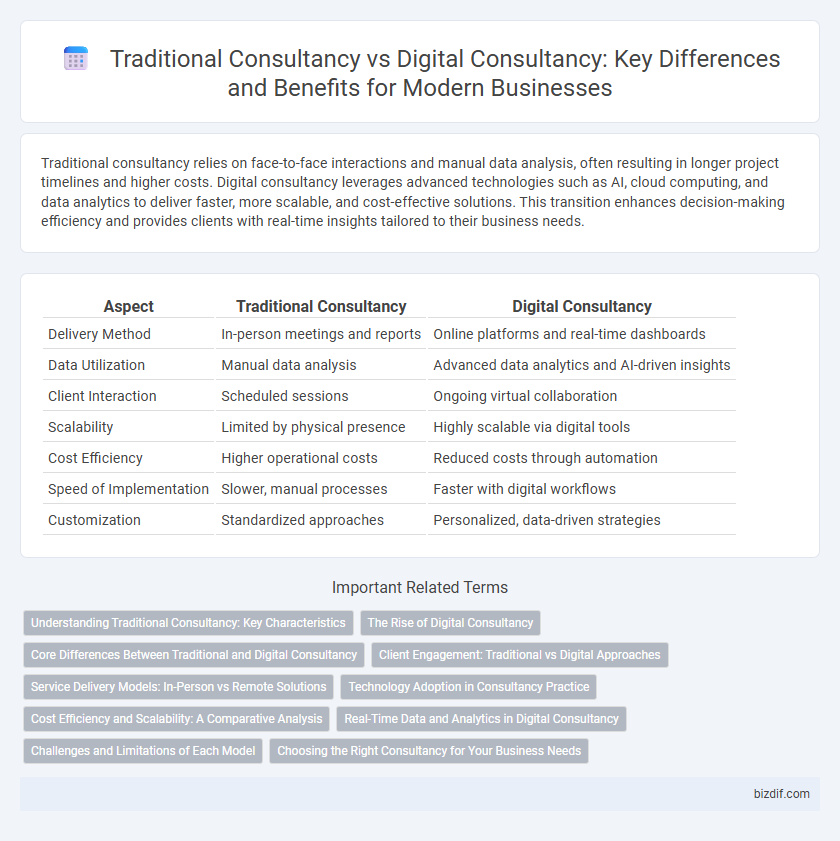Traditional consultancy relies on face-to-face interactions and manual data analysis, often resulting in longer project timelines and higher costs. Digital consultancy leverages advanced technologies such as AI, cloud computing, and data analytics to deliver faster, more scalable, and cost-effective solutions. This transition enhances decision-making efficiency and provides clients with real-time insights tailored to their business needs.
Table of Comparison
| Aspect | Traditional Consultancy | Digital Consultancy |
|---|---|---|
| Delivery Method | In-person meetings and reports | Online platforms and real-time dashboards |
| Data Utilization | Manual data analysis | Advanced data analytics and AI-driven insights |
| Client Interaction | Scheduled sessions | Ongoing virtual collaboration |
| Scalability | Limited by physical presence | Highly scalable via digital tools |
| Cost Efficiency | Higher operational costs | Reduced costs through automation |
| Speed of Implementation | Slower, manual processes | Faster with digital workflows |
| Customization | Standardized approaches | Personalized, data-driven strategies |
Understanding Traditional Consultancy: Key Characteristics
Traditional consultancy relies heavily on in-person interactions, hierarchical decision-making, and standardized methodologies rooted in long-established industry practices. It emphasizes detailed reports, formal client meetings, and structured project timelines to deliver insights and recommendations. Often, traditional consultancy engages with legacy systems and emphasizes experience-based strategies over data-driven or automated solutions.
The Rise of Digital Consultancy
Digital consultancy leverages advanced technologies such as data analytics, AI, and cloud computing to deliver agile, scalable solutions, outperforming traditional consultancy models that rely heavily on manual processes and face-to-face interactions. The rise of digital consultancy is driven by increasing demand for real-time insights, personalized strategies, and automated decision-making across industries. Businesses that adopt digital consultancy gain competitive advantages through enhanced efficiency, innovation, and data-driven outcomes.
Core Differences Between Traditional and Digital Consultancy
Traditional consultancy relies heavily on face-to-face interactions, physical meetings, and manual data analysis, while digital consultancy leverages advanced technologies like AI, data analytics, and cloud-based platforms to deliver real-time insights. Digital consultancy emphasizes scalable solutions, automation, and remote collaboration, contrasting with the often slower, process-driven methods of traditional consultancy. Core differences also include the adaptability and speed of digital consultancy to market changes, making it more agile and efficient in addressing client needs.
Client Engagement: Traditional vs Digital Approaches
Traditional consultancy typically relies on in-person meetings, scheduled calls, and physical documentation to engage clients, emphasizing personal relationships and direct communication. Digital consultancy leverages advanced technologies such as CRM platforms, virtual collaboration tools, and data analytics to create real-time, interactive client experiences. The digital approach enhances responsiveness and accessibility, enabling continuous engagement and customized solutions tailored to client needs.
Service Delivery Models: In-Person vs Remote Solutions
Traditional consultancy relies heavily on in-person service delivery models, emphasizing face-to-face interactions and on-site client engagement for tailored solutions. Digital consultancy leverages remote solutions through virtual meetings, cloud-based collaboration tools, and real-time data analytics to enhance flexibility and scalability. The shift from physical presence to digital platforms enables faster response times and broader access to global expertise, transforming client-consultant engagement dynamics.
Technology Adoption in Consultancy Practice
Traditional consultancy relies heavily on in-person expertise and legacy analytical tools, often resulting in slower decision-making processes. Digital consultancy leverages advanced technologies such as artificial intelligence, data analytics, and cloud computing to enhance real-time insights and agile strategy implementation. Technology adoption in consultancy practice drives innovation, improves accuracy, and enables scalable solutions tailored to dynamic market demands.
Cost Efficiency and Scalability: A Comparative Analysis
Traditional consultancy often incurs higher fixed costs due to extensive on-site visits and manual data processing, limiting scalability and increasing overall expenses. Digital consultancy leverages cloud-based tools and AI-driven analytics, significantly reducing operational costs while enabling rapid scaling across multiple projects and regions. This shift enhances cost efficiency by automating routine tasks and providing real-time insights, allowing businesses to adapt swiftly to market demands.
Real-Time Data and Analytics in Digital Consultancy
Digital consultancy leverages real-time data and advanced analytics to deliver instant insights, enabling businesses to make agile, data-driven decisions and optimize strategies on the fly. Traditional consultancy often relies on historical data and periodic reports, which can delay response times and limit adaptability in dynamic market conditions. Real-time analytics platforms in digital consultancy integrate various data sources, enhancing predictive accuracy and providing continuous performance monitoring for sustained competitive advantage.
Challenges and Limitations of Each Model
Traditional consultancy struggles with scalability and high operational costs due to its reliance on in-person interactions and manual data analysis. Digital consultancy faces challenges in data security, technology integration, and maintaining personalized client relationships despite leveraging AI and automation tools. Both models must address evolving client expectations and the rapid pace of technological change to remain competitive.
Choosing the Right Consultancy for Your Business Needs
Traditional consultancy offers personalized, face-to-face advisory services with a focus on established industry practices and long-term relationships, ideal for businesses seeking deep expertise and hands-on support. Digital consultancy leverages advanced technologies such as AI, data analytics, and cloud solutions to deliver scalable, real-time insights and agile strategies, making it suitable for companies aiming to innovate and accelerate digital transformation. Selecting the right consultancy depends on your business goals, whether you require proven methodologies or cutting-edge digital tools to drive growth and efficiency.
Traditional consultancy vs Digital consultancy Infographic

 bizdif.com
bizdif.com